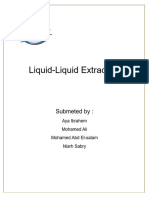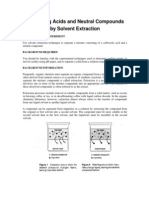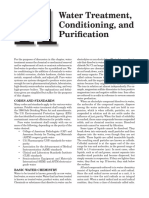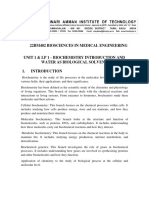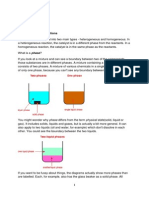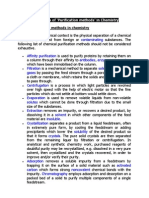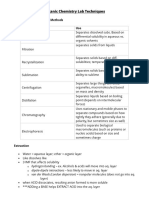Liquid
Liquid
Uploaded by
Muhammad ChawlaCopyright:
Available Formats
Liquid
Liquid
Uploaded by
Muhammad ChawlaCopyright
Available Formats
Share this document
Did you find this document useful?
Is this content inappropriate?
Copyright:
Available Formats
Liquid
Liquid
Uploaded by
Muhammad ChawlaCopyright:
Available Formats
Liquidliquid extraction, also known as solvent extraction and partitioning, is a method to separate compounds based on their relative solubilities
in two different immiscible liquids, usually water and an organic solvent. It is an extraction of a substance from one liquid phase into another liquid phase. Liquidliquid extraction is a basic technique in chemical laboratories, where it is performed using a separatory funnel. This type of process is commonly performed after a chemical reaction as part of the work-up. The term partitioning is commonly used to refer to the underlying chemical and physical processes involved in liquidliquid extraction but may be fully synonymous. The term solvent extraction can also refer to the separation of a substance from a mixture by preferentially dissolving that substance in a suitable solvent. In that case, a soluble compound is separated from an insoluble compound or a complex matrix. Solvent extraction is used in nuclear reprocessing, ore processing, the production of fine organic compounds, the processing of perfumes, the production of vegetable oils and biodiesel, and other industries. Liquidliquid extraction is possible in non-aqueous systems: In a system consisting of a molten metal in contact with molten salts, metals can be extracted from one phase to the other. This is related to a mercury electrode where a metal can be reduced, the metal will often then dissolve in the mercury to form an amalgam that modifies its electrochemistry greatly. For example, it is possible for sodium cations to be reduced at a mercury cathode to form sodium amalgam, while at an inert electrode (such as platinum) the sodium cations are not reduced. Instead, water is reduced to hydrogen. A detergent or fine solid can be used to stabilize an emulsion, or third phase.
EXPLANATION
Liquids that form two layers when mixed provide an opportunity for purification of materials that prefer one layer more than the other. For example, many organic chemicals are liquids that are very non-polar and separate from water because it is quite polar. Benzene mixed with water, shaken, and allowed to stand will result in a layer of benzene on top of a layer of water. If the water originally contained some non-polar material such as butanol, shaking with benzene would result in a benzene layer rich in butanol. At equilibrium, the activities of the dissolved material must be the same in each phase. We can approximate activity with concentration to get the definition of distribution coefficient :
You might also like
- Solubilities: Liquid-Liquid Extraction (LLE), Also Known As Solvent Extraction and PartitioningDocument1 pageSolubilities: Liquid-Liquid Extraction (LLE), Also Known As Solvent Extraction and PartitioningMagesh kumarNo ratings yet
- LLEDocument14 pagesLLENiarh SabryNo ratings yet
- Distillation CoulmnsDocument20 pagesDistillation CoulmnsMuhammad Hamza NaveedNo ratings yet
- Separating Acids and Neutral Compounds by Solvent Extraction 705Document11 pagesSeparating Acids and Neutral Compounds by Solvent Extraction 705irohanihoheto12350% (2)
- Chapter 13Document36 pagesChapter 13Arlane M. AbenojaNo ratings yet
- Lecture 4Document4 pagesLecture 4jiaracameron101No ratings yet
- Chemical Earth NotesDocument15 pagesChemical Earth NotesLuluNo ratings yet
- Liquid - Liquid ExtractionDocument15 pagesLiquid - Liquid ExtractionDeepChacNo ratings yet
- CH 11Document40 pagesCH 11salmanistiaq0No ratings yet
- Chemistry Homogeneous Mixture: SolventDocument19 pagesChemistry Homogeneous Mixture: SolventRUZCHEMISTRYNo ratings yet
- Babhem Separation TechniquesDocument3 pagesBabhem Separation TechniquesHrshy AelaNo ratings yet
- Solvent Extraction Process and ApplicationsDocument4 pagesSolvent Extraction Process and ApplicationsSyedMeherAliNo ratings yet
- Classification of MatterDocument38 pagesClassification of MatterNR AdawiyahNo ratings yet
- Classification of MatterDocument14 pagesClassification of Matteryanelys RosadoNo ratings yet
- Distilled, Deionised and Demineralised Water and Measuring of The PurityDocument5 pagesDistilled, Deionised and Demineralised Water and Measuring of The PurityVel MuruganNo ratings yet
- Identify The Difference Between Elements, Compounds and Mixtures in Terms of Particle TheoryDocument17 pagesIdentify The Difference Between Elements, Compounds and Mixtures in Terms of Particle TheoryBenjamin PangNo ratings yet
- Week 2-Notes Classification and Separation of MatterDocument3 pagesWeek 2-Notes Classification and Separation of MatterAlyssa Crizel CalotesNo ratings yet
- Chemical and Biological Treatment For Waster Waste Plants Tanghal 14A - 15ADocument3 pagesChemical and Biological Treatment For Waster Waste Plants Tanghal 14A - 15Ajuvicgaviola.202100357No ratings yet
- 2210 - ExtractionDocument13 pages2210 - ExtractionChandra Icha KurniauanNo ratings yet
- 22BM402 LM1Document8 pages22BM402 LM1navaneetsvNo ratings yet
- Clarification of WaterDocument41 pagesClarification of WaterpicefeatiNo ratings yet
- Liquid-Liquid ExtractionDocument8 pagesLiquid-Liquid Extractionrr1819No ratings yet
- Liquid Liquid NotesDocument28 pagesLiquid Liquid NotesTINOTENDA TERANo ratings yet
- Separation Techniques Notes 1..(for FY)Document49 pagesSeparation Techniques Notes 1..(for FY)tamanna090506No ratings yet
- Elements Compounds and Mixtures PDFDocument3 pagesElements Compounds and Mixtures PDFJam Aica100% (1)
- Distilled, Deionized and Demineralized Water and Measuring of The PurityDocument5 pagesDistilled, Deionized and Demineralized Water and Measuring of The PurityAli Emraan TariqNo ratings yet
- CHEM 2 - Module 3 Review of FundamentalsDocument3 pagesCHEM 2 - Module 3 Review of FundamentalsMicah BlazaNo ratings yet
- Applied Chemistry Unit 2 - Nature of Matter-1Document14 pagesApplied Chemistry Unit 2 - Nature of Matter-1joyunspeakableu7No ratings yet
- Separation Processes SummaryDocument4 pagesSeparation Processes SummarynydiamdrNo ratings yet
- CatalysisDocument9 pagesCatalysisDhiviya GanesanNo ratings yet
- Week 2 - 3 - Mixtures & SeparationDocument3 pagesWeek 2 - 3 - Mixtures & SeparationJenmar HemmingsNo ratings yet
- Biochem - Water & PHDocument18 pagesBiochem - Water & PHkeith ramlynNo ratings yet
- Chemical Water TreatmentDocument12 pagesChemical Water TreatmentEderango JackNo ratings yet
- WaterDocument12 pagesWaterngogiabao.kbNo ratings yet
- 3-Liquid-Liquid Extraction+TLCDocument16 pages3-Liquid-Liquid Extraction+TLCLinh NguyễnNo ratings yet
- Solvent Extraction Updated 14.02.2012Document5 pagesSolvent Extraction Updated 14.02.2012Loveena SteadmanNo ratings yet
- SolutionsDocument5 pagesSolutionsRuwandi BandaraNo ratings yet
- Pharmaceutical Solutions and SolubilityDocument14 pagesPharmaceutical Solutions and SolubilityOke OluwafemiNo ratings yet
- Demineralized Process Water..Document52 pagesDemineralized Process Water..teweleNo ratings yet
- Colloids Shape and Size and Prep NotesDocument12 pagesColloids Shape and Size and Prep NotesNavnath HatvateNo ratings yet
- An Introduction To Types of CatalysisDocument6 pagesAn Introduction To Types of CatalysisVIKKASH A/L RAJAGOPAL STUDENTNo ratings yet
- Some Terms of Purification Methods' in ChemistryDocument8 pagesSome Terms of Purification Methods' in ChemistryMd.Mehdi MasudNo ratings yet
- Pharmaceutical Solutions and SolubilityDocument8 pagesPharmaceutical Solutions and Solubilitysojevictoria1No ratings yet
- Water and SupplyDocument17 pagesWater and SupplyRica JeanneNo ratings yet
- Separation Science - Chromatography Unit Thomas Wenzel Department of Chemistry Bates College, Lewiston ME 04240 Twenzel@bates - EduDocument69 pagesSeparation Science - Chromatography Unit Thomas Wenzel Department of Chemistry Bates College, Lewiston ME 04240 Twenzel@bates - EduthecriticNo ratings yet
- Organic Chemistry Lab Technique Notes For The DATDocument3 pagesOrganic Chemistry Lab Technique Notes For The DATOscar Federico SpadaNo ratings yet
- Definition of Mass TransferDocument6 pagesDefinition of Mass TransferBruno Lupi Barroso50% (2)
- Advanced Wastewater TreatmentDocument16 pagesAdvanced Wastewater TreatmentvikkykambleNo ratings yet
- Studymaterial_is Matter Around Us Pure_( Part 3)_CLASSIXDocument17 pagesStudymaterial_is Matter Around Us Pure_( Part 3)_CLASSIXvaidyakarunalataNo ratings yet
- 12-Crystallization, Extraction and Sublimation & QsDocument8 pages12-Crystallization, Extraction and Sublimation & QsNgọc TrânNo ratings yet
- Elements Compounds MixturesDocument0 pagesElements Compounds MixturesAdnan ChowdhuryNo ratings yet
- Liquid-Liquid Extraction - WikipediaDocument51 pagesLiquid-Liquid Extraction - Wikipediaayesharehman02428No ratings yet
- Is Matter Around Us PureDocument25 pagesIs Matter Around Us PureGaurav MehndirattaNo ratings yet
- Water Purification Is The Process of Removing Undesirable Chemicals, BiologicalDocument3 pagesWater Purification Is The Process of Removing Undesirable Chemicals, BiologicalSapaNo ratings yet
- Oil and Water Won't Mix and Other Mixture Separation Techniques - Chemistry Book for Kids 8-10 | Children's Chemistry BooksFrom EverandOil and Water Won't Mix and Other Mixture Separation Techniques - Chemistry Book for Kids 8-10 | Children's Chemistry BooksNo ratings yet
- Combining Chemicals - Fun Chemistry Book for 4th Graders | Children's Chemistry BooksFrom EverandCombining Chemicals - Fun Chemistry Book for 4th Graders | Children's Chemistry BooksNo ratings yet
- Ion Exchange Resins and Adsorbents in Chemical Processing: Second EditionFrom EverandIon Exchange Resins and Adsorbents in Chemical Processing: Second EditionRating: 5 out of 5 stars5/5 (1)
- Chapter 14 Location & LayoutDocument36 pagesChapter 14 Location & LayoutMuhammad ChawlaNo ratings yet
- Nanotechnology and Its Applications in Catalysis and Membrane TechnologyDocument19 pagesNanotechnology and Its Applications in Catalysis and Membrane TechnologyMuhammad ChawlaNo ratings yet
- Chapter 11 Financial PlanDocument37 pagesChapter 11 Financial PlanMuhammad ChawlaNo ratings yet
- E-Commerce and The EntrepreneurDocument32 pagesE-Commerce and The EntrepreneurnewaznahianNo ratings yet
- Calendering - 8Document14 pagesCalendering - 8Muhammad ChawlaNo ratings yet
- DiagramDocument15 pagesDiagramMuhammad ChawlaNo ratings yet
- 4th B.Com SSDocument1 page4th B.Com SSMuhammad ChawlaNo ratings yet

